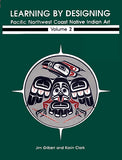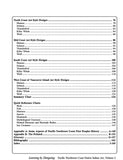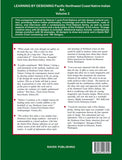Learn about Indigenous art styles of the Northwest Coast peoples within a First Nations’ cultural context
Learning by Designing Pacific Northwest Coast Native Indian Art, Volume 2, by Jim Gilbert and Karin Clark, is a companion manual to Volume 1 that dives deeper into a First Nations’ cultural context for the Indigenous art styles of the Northwest Coast peoples.
This book includes interviews showcasing four contemporary Indigenous voices that provide a cultural context for the Indigenous art styles of Northwest Pacific Coast peoples.
To provide you with a deeper First Nations’ cultural context for Northwest Coast Indigenous art styles, this book includes in-depth interviews with Northwest Coast First Nations community members Ruth Cook, George Cook, Nella Nelson, and Wedlidi Speck.
Indigenous values, ethics, and history as a backdrop for Northwest Coast Indigenous art styles.
Ruth, George, Nella, and Wedlidi give you a glimpse into Indigenous values, perspectives, ethics, and history of Northwest Coast Indigenous peoples in Canada.
This book also includes a Traditional First Nations Code of Ethics and Twelve Principles of Indigenous Philosophy, so you can integrate Indigenous perspectives into your understanding of Indigenous art styles of Northwest Coast peoples.
Bonus 1: Volume 2 includes a full-colour, 16-page creation story, In the Beginning There was the First World, written by one of our interviewees and collaborators Wedlidi Speck.
Bonus 2: You’ll find a helpful quick reference chart with over 100 Indigenous animal art designs, including 12 types of birds, 12 types of fish, 10 human figure designs, 4 types of insects, 18 types of mammals, 17 types of mythological creatures, 15 types of natural elements, and 8 types of seafood creatures.
More about Learning by Designing, Volume 2:
- This companion manual to Volume 1 puts First Nations Northwest Coast art into deeper cultural context, providing Indigenous philosophy, knowledge, and skills foundation, a code of ethics, and interviews with First Nations community members Ruth Cook, George Cook, Nella Nelson, and Wedlidi Speck, as well as some aspects of historical context and a description of the Potlatch.
- The companion manual includes a full colour, 16-page creation story with 20 designs.
- Additional topics include contemporary indigenous art design evolution with 50 examples, 20 designs to draw and paint, and a Quick Reference Chart containing over 100 designs.
- Volume 2 was first published in 2002 and reprinted in 2007 and 2017. It has sold over 15,000 copies to date.
Customer Reviews
“Volume 2 continues to be a helpful resource for budding artists and a worthy addition to the bookshelf of any Northwest Coast artist." — Andy Everson, K’ómoks First Nations Artist/Anthropologist. Comox, B.C.
“Learning by Designing Pacific Northwest Coast Native Indian Art, Volume 2 is a very thorough, well-researched book that will be of great value to anyone interested in learning more about Northwest Coast First Nations art. The design terminology is straightforward, well explained, and easy to understand. Especially valuable is the separation and consistent identification of different coastal styles: Northern, Mid-coast, ‘west coast,’ and southern coast. This clearly denotes these divergent individual traditions and credits these regions and First Nations with their unique historical design contributions. — Steve Brown, Author/Artist, Former Curator of Native American Art, Seattle Art Museum. Seattle, Washington.
“I am even more impressed with this volume than the last. It offers so many new tools and insights that allow one to create imaginative and lively designs that incorporate the numerous elements of the art form. The carver in me got really excited at what I found … The patterns are beautiful and the combinations almost endless. — F. (Bill) Judt, relief carver, Saskatoon, Saskatchewan, Canada.
“There is so much information packed into this extremely well-written and exhaustively researched second volume, I found myself reading many pages twice, just to make sure that I had absorbed all of the fascinating text … Kudos to Karin Clark and the late Jim Gilbert, whose tireless efforts and endless research have resulted in two classic volumes which are surely destined to find their way as valued additions to libraries, schools, cultural institutions and other places of learning throughout North America. — Reg Ashwell, Freelance writer and Northwest Coast art dealer and collector, Vancouver Island, British Columbia
_____________________________________
Table of Contents
Acknowledgments
About the Authors
Preface
Introduction
Goals
Overview of Learning by Designing
Building on a First Nations Foundation
Traditional First Nations Code of Ethics
Twelve Principles of Aboriginal Philosophy
First Nations Knowledge and Skills Foundation
Four Worlds Colour Section
Aboriginal Art within a Cultural Context
Talking with one contemporary First Nations Family
Ruth Cook
George Cook
Nella Nelson
Wedlidi Speck
Introduction to Design
Formline
Evolution and Formation of Design Shapes
Evolution of the Ovoid - The Salmon Egg/Salmon Head Theory
Two-Dimensional Design Styles
Semi-Realistic Design Styles
Extended and Rearranged Design Styles
Myth Interpretation /Reading a Rearranged Design
Reading a Two-Dimensional Design
Overlapping - Depth and Perspective
Perspective - Birds Wings and Tails
The Elements - Rain, Clouds, Snow, Water, Ocean
Trees and Coastal Islands
Painting and Colours
Basketry Designs - Geometric, Decorative, Animal, Woven or Painted
Decorated Garments
Decorative Garments - Button and Applique
Contemporary Garments
Culture & Art Style Regions of the Pacific Northwest Coast
Map: Four Major Art Style Regions of the Pacific Northwest Coast
Full Designs in the Style of the Four Art Areas
North Coast Designs
Human
Salmon
Thunderbird
Killer Whale
Wolf
Mid Coast Designs
Human
Salmon
Thunderbird
Killer Whale
Wolf
South Coast Designs
Human
Salmon
Thunderbird
Killer Whale
Wolf
West Coast of Vancouver Island Designs
Human
Salmon
Thunderbird
Killer Whale
Wolf
Summary Chart
Quick Reference Charts
Birds
Fish
Humans
Insects
Mammals
Mythological Creatures
Natural Elements and Heavenly Bodies
Sea Creatures
Appendices
Appendix A: Some Aspects of History of the Coastal First Peoples
Appendix B: The Potlatch
Glossary
Bibliography
Index








